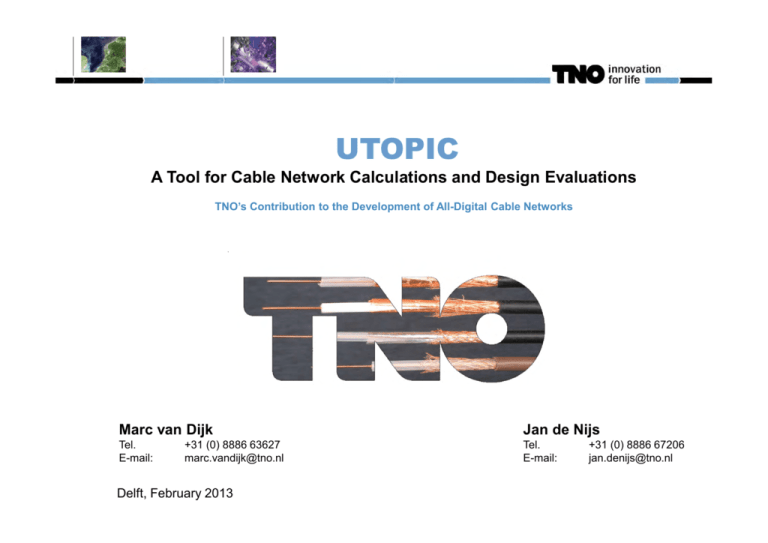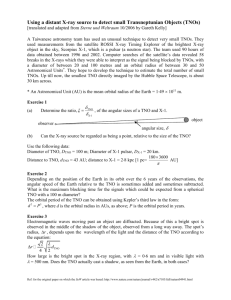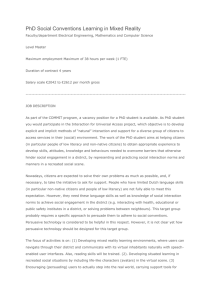UTOPIC - A Tool for Cable Network Calculations and Design
advertisement

UTOPIC A Tool for Cable Network Calculations and Design Evaluations TNO’s Contribution to the Development of All-Digital Cable Networks Marc van Dijk Jan de Nijs Tel. E-mail: Tel. E-mail: +31 (0) 8886 63627 marc.vandijk@tno.nl Delft, February 2013 +31 (0) 8886 67206 jan.denijs@tno.nl 2 February 2013 UTOPIC: TNO’s Contribution to the Cable Cable Evolution toward Gbps services The HFC network is a most crucial asset of a cable operator. From the financial viewpoint it represents a huge investment. Moreover, the development toward a Gbps infrastructure for future premium television and broadband services requires further network investments. This year, next year and many years to come*. Planning the investments in a most efficient manner will yield millions of savings. This year, next year and many ….. New modulation schemes, replacement of analogue by digital services, segmentations, extensions and/or rearrangement of the frequency plan, deep fibre etc. all require a careful reconsideration of the RF design of the cable network. From the business and technical viewpoint, a satisfactory solution with a good balance between network investments and network performance has to be found. * “Evolution and prospects cable networks for broadband services - A technical perspective of the European and specifically the Dutch cable networks”, TNO, October 2012. 3 February 2013 UTOPIC: TNO’s Contribution to the Cable The Challenge of Cable Network Evolution A compromise between business and technical requirements From the business viewpoint, the design and management of an HFC network is quite challenging. A trade-off has to be made between: • Customer satisfaction (service reliability & quality), • Network investments and, • Operational costs to solve network-related customer complaints. Business balance RF balance From the RF engineering viewpoint, the design and management of an HFC network is equally challenging. A trade-off has to be made between: • Signal quality (customer satisfaction), • Network load and, • Network power budget. UTOPIC is an unique aid for HFC design challenges, to make a trade off between technical requirements (signal quality) and business interests (investments) 4 February 2013 UTOPIC: TNO’s Contribution to the Cable What UTOPIC does? UTOPIC is a tool for cable system calculations. For a given cable network configuration and load, the signal level (S), thermal noise level (N) and intermodulation signal level (I) is calculated for each carrier at the system outlet. For a good network performance, the signal level S, S/N ratio and S/I ratio must be compliant with the signal requirements as given in the IEC 60728-1. Finalist SCTE 2009 Technological Innovation of the Year Award UTOPIC has been developed with support of 5 February 2013 UTOPIC: TNO’s Contribution to the Cable UTOPIC: the business challenge Save millions on investments and operational costs Maximize the HFC network load (capacity) with minimum investments and without dissatisfied customers or higher operational costs. UTOPIC helps addressing questions like: Is it feasible to replace one or more analogue channels by digital channels, or to add digital carriers? Is it feasible to migrate from 64 QAM to 256 QAM? What services can be delivered using spectrum beyond the current frequency edge and/or using new 1024 QAM or higher modulation schemes, for instance for DOCSIS 3.1 ? Do we have a case to management to invest in new components For replacement investments, UTOPIC makes it easy to compare the network performance for different amplifiers or nodes. UTOPIC is a convenient aid for component selection. Harmonizing the network load and channel plan of different networks offers interesting benefits, but often such an harmonization is a difficult engineering project because of the different network designs and use of different components. UTOPIC is a tool that relieves such design challenges. It helps identifying the capacity bottle necks, and finding the cheapest but appropriate solutions. 6 February 2013 UTOPIC: TNO’s Contribution to the Cable UTOPIC: the RF engineering challenge Improve, accelerate and reduce costs of cable network engineering In former (analogue only) times, CSO/CTB calculations were used for the cable RF design. Today, with digital loads such calculations give much too optimistic results.* For an accurate result 5th and even 7th order distortion signals have to be included. UTOPIC is a unique software tool for cable performance calculation that accurately and rapidly calculates these higher order distortion signals. Cable engineering is a laborious work that as a rule involves extended tests and measurements. UTOPIC can replace part of these tests. UTOPIC can be used to increase the number network configurations or components to evaluate. UTOPIC gives a quick result in contrast to time-consuming tests in an RF lab. UTOPIC is validated: • “A component model for cable system calculations”, Broadband, Vol 34, No 3, September 2012 • “System Calculations for Cable Networks with digital Load”, Broadband, Vol 35, No 2, March 2013 For input standardised specification data (IEC 6078-3 and IEC 60728-3-1) are used. It calculates the cable performance requirements for analogue and digital services as specified in IEC 60728 – 1. * Methodology for Specifying HFC Networks and Components, ReDeSign, Deliverable D10, 2009, www.ict-redesign.eu 7 February 2013 UTOPIC: TNO’s Contribution to the Cable UTOPIC Customer Testimonials “For every new channel, UTOPIC can calculate quick as lightning the impact it will have within the network and, therefore, on the customer” “With help of UTOPIC, it became visible that the - believed 15% unsuitable – trunk was still suitable. Thereby making an alternative fibre investment of millions unnecessary.” “We can really pinpoint the bottlenecks in our network with the UTOPIC tool and upgrade the performance of the entire network by upgrading only a few components, thereby minimizing costs.” “With help of UTOPIC all digital QAM-64 channels could be adjusted to QAM-256, thereby increasing bandwidth from 40 to 50 Mbit/s per channel: 10 – 15% less network investments were necessary (>> 1 M€).” “UTOPIC is heavily used during vendor selection: the tool provides information about how the performance of the components of the specific vendor in our network will be.” 8 February 2013 UTOPIC: TNO’s Contribution to the Cable TNO Offer for European MSOs A new approach to HFC engineering and HFC business trade-offs UTOPIC offers a new approach for HFC network engineering. To reap the full benefits of an improved RF engineering and/or a more efficient use and management of the HFC network, the method of system calculations should be widely adopted. Therefore, TNO offers European MSOs: • • • • • A 3 year contract for the use of UTOPIC R6.0 and maintenance upgrades, with annual opt out possibility An on-site UTOPIC training (first year) Back-office UTOPIC support Specification of 2 cable amplifiers conform IEC 60728 part 3-1 Clause 4.2 (CINR curves at low, mid and high frequency) in the first year, Each year you may decide to terminate the contract without further costs. 9 February 2013 UTOPIC: TNO’s Contribution to the Cable TNO Offer for Vendors A new approach for HFC engineering UTOPIC offers a new approach for HFC network engineering. To reap the full benefits of an improved RF engineering and/or a more efficient use and management of the HFC network, the method of system calculations should be widely adopted. Therefore, TNO offers vendors: • A 3 year contract for the use of UTOPIC R6.0 and maintenance upgrades, with annual opt out possibility • The obligation to deposit for UTOPIC relevant measured* component data of your amplifiers and nodes of your current product portfolio in a database; MSOs can retrieve the component data from this database for calculations that include your component. The data include all measured data of a IEC 60728 part 3 (CENELEC measurement) and IEC 60728 part 3-1 measurement. • The use of UTOPIC is limited to own projects and network design assignments of customers. • Each year you may decide to terminate the contract without further costs. * All measured data refers to the 42 CSO and CTB figures of the IEC 60728-3 measurement (Clause 4.2) and the low, mid and high frequency CINR curves of IEC 60728-3-1 (Clause 4.2). 10 February 2013 UTOPIC: TNO’s Contribution to the Cable For further information Jan de Nijs Tel. Email: xx31(0)88 86 67 206 jan.denijs@tno.nl 11 February 2013 UTOPIC: TNO’s Contribution to the Cable TNO: Mission and Organisation TNO connects people and knowledge to create innovations that boost the sustainable competitive strength of industry and well-being of society Mission TNO is a Dutch, independent and non for profit research organisation whose expertise and research make an important contribution to the competitiveness of companies and organisations, to the economy and to the quality of society as a whole. TNO’s unique position is attributable to its versatility and capacity to integrate this knowledge. Innovation with purpose is what TNO stands for. We develop knowledge not for its own sake but for practical application. To create new products that make life more pleasant and valuable and help companies innovate. To find creative answers to the questions posed by society Organisation Focus and mass are critical success factors, TNO concentrates on 7 closely related themes, each of which has a prominent place in the national and European innovation agenda. The themes are derived from a clustering (based on strong interrelationships) and refined focusing of the twelve themes from the previous strategy period and are thus a logical extension. • Built environment • Industrial innovation • Information society • Healthy living • Defense, Safety and Security • Energy • Mobility Turnover In 2011 the total consolidated income was 577 million euros a third of which - 189 million euros - was government funding for the purpose of developing new knowledge. Our employees For a research organisation, employees are crucial, which is why TNO constantly invests in talent development, management development and recruitment strategy. Of the more than 3,900 employees, almost 700 work at TNO Companies BV and 61 employees are engaged outside of the Netherlands 12 February 2013 UTOPIC: TNO’s Contribution to the Cable Basics calculation cable intermodulation products in UTOPIC Information on UTOPIC can be found: “UTOPIC a new RF planning tool for cable networks” Broadband, Vol. 30, No 3, December 2008 “A component model for cable system calculations”, Broadband, Vol. 34, No 3, September 2012 www.tno.nl/utopic www.tno.nl/cable For analogue signals, narrowband distortion signals (CSO and CTB cluster beats) are generated. Already the beats of 2nd and 3rd order distortion signals yield a visible degradation of the picture; For digital loads, non-linear distortion signals are spread out in the frequency domain. In most cases, the 2nd and 3rd order distortion signals remain below the thermal noise level. If so, 5th and higher order distortion signals dominate signal degradation of digital carriers. UTOPIC calculated all analogue-analogue, analogue-digital and digital-digital intermodulation products up to the 7th order. Next it calculated all signal performance requirements such as the carrier-to-thermal noise ratio of PAL and DVB-C carries (IEC 60728-1, Clause 5.8), the multiple frequency intermodulation interference for PAL carriers (IEC 60728-1, Clause 5.9.3), and the carrier to intermodulation noise ratio for digital carriers (new IEC 60728-101).






